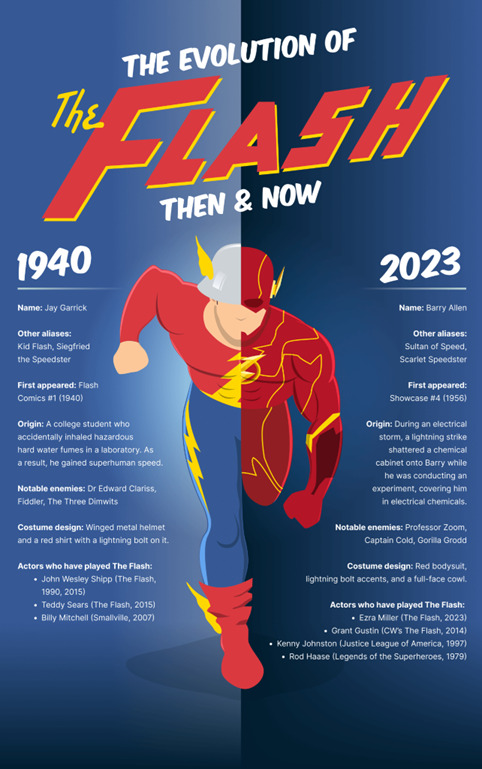The Flash is one of the most iconic superheroes in comic book history. Since 1940, several incarnations of the speedster have graced the pages of DC comics, racing through adventures at supersonic speeds. The Flash has become a key part of the DC universe and a fan favorite for generations.
The original Flash was Jay Garrick, a college student who gained super-speed abilities after inhaling heavy water vapors. Debuting in Flash Comics #1, Jay fought crime and evil-doers for over 50 years. In 1956, the Silver Age Flash, Barry Allen, made his first appearance, revitalizing the character for modern audiences. After Barry’s death, Wally West took up the mantle of the Flash, continuing the legacy into the 21st century.
According to Express VPN, The Flash, as a character, experienced many changes throughout the years, from his costume design and aliases to the enemies he fought. However, with all the changes, the one thing that remains the same is what he represents, hope, heroism, and the thrill of high-speed adventure.
Whether it’s Jay, Barry, or Wally in the iconic red suit, the Flash continues fighting for truth and justice at speeds mere mortals can only imagine. This is a brief history of the Flash, the superhero who made running cool.
The Golden Age Flash: Jay Garrick
The first super-speedster of the Golden Age of comics was Jay Garrick, the original Flash. Introduced in Flash Comics #1 in 1940, Jay Garrick was a college student who gained super-speed abilities after inhaling heavy water vapors.
- Jay Garrick’s powers allowed him to run at superhuman speeds, giving him super-speed and quick reflexes. He used these powers to fight crime in his hometown of Keystone City. Jay wore a distinctive winged helmet and a red shirt with a lightning bolt emblem, establishing the iconic look for the Flash that continues today.
- Jay was a founding member of the Justice Society of America, DC’s first superhero team. He fought villains like the Thinker, the Fiddler, and the Shade. After World War II, superhero comics declined in popularity, and Flash Comics ended in 1949 after 104 issues.
- However, during the Silver Age of comics, DC revived the Flash in a new incarnation, police scientist Barry Allen. Jay Garrick was reintroduced in Flash #123 (1961) as an elder mentor to the new Flash. Since then, Jay has made frequent appearances as the elder statesman of speedsters in the DC Universe.
- Jay Garrick showcased the possibility of super-speed powers in comics and established many of the tropes associated with the Flash legacy. Though sometimes overlooked, Jay’s role as the original Flash and mentor to subsequent speedsters has cemented his status as an important figure in DC’s mythology.
The Silver Age Flash: Barry Allen
The Silver Age Flash, Barry Allen, first appeared in Showcase #4 in 1956. This version of the Flash was a police scientist who gained super-speed after being doused in chemicals and struck by lightning.
Barry Allen’s Flash operated in Central City and worked as a crime scene investigator. His super speed allowed him to solve crimes quickly and surreptitiously. The Flash could run at supersonic speeds, vibrate his molecules through solid objects, and travel through time. His archenemy was the Reverse-Flash, Eobard Thawne, a villain from the future with similar powers.
The Flash joined the Justice League of America and had many adventures with them. Notable storylines include “Flash of Two Worlds” where Barry first traveled to Earth-Two and met Jay Garrick, the Golden Age Flash. The Flash also raced Superman in “Superman’s Race With the Flash!” to determine who was truly faster.
Tragically, Barry Allen sacrificed his life during the Crisis on Infinite Earths event in 1985, saving millions of lives. However, Barry’s legacy as an iconic Silver Age superhero lives on. His nephew Wally West took up the mantle of the Flash for decades. Barry Allen remains an inspiration, demonstrating that one person with extraordinary powers can make a difference through courage, compassion, and moral integrity.
The Silver Age Flash brought lightness and wonder during a pivotal time in comics. Barry Allen’s Flash will always be remembered as a pivotal superhero who ushered in a new era of positivity and imagination.
Wally West Becomes the Flash
The Death of Barry Allen
In 1985, DC Comics made the controversial decision to kill off Barry Allen, the second Flash, in the Crisis on Infinite Earths miniseries. With the Silver Age Flash gone, DC needed a new character to take up the mantle of the Scarlet Speedster. They turned to Barry Allen’s nephew and former sidekick, Wally West.
Wally West Becomes The Flash
Wally West was introduced in 1959 as Kid Flash, Barry Allen’s teen sidekick. When Barry sacrificed himself to save the universe during the Crisis, Wally took over as the Flash. Unlike the squeaky-clean Barry, Wally was portrayed as a womanizing hothead. Under writer Mike Baron, Wally came into his own. Baron established Wally as a more lighthearted and funny character than Barry. Mark Waid’s run further developed Wally, maturing him into a hero in his own right.
Building His Own Legacy
At first, Wally was in Barry’s shadow and struggled to live up to his legacy. But Waid and artist Mike Wieringo crafted a new look and new villains for Wally, helping him step out of Barry’s shadow. They also expanded Wally’s powers, giving him the ability to vibrate through objects and accelerate his molecules. Wally formed deeper relationships with other heroes like Green Lantern Kyle Rayner and built a family of his own with reporter Linda Park. Wally cemented himself as DC’s premier Flash for over 20 years.
Passing the Torch
In 2009, Wally’s story came to an end in Flash: Rebirth. Like his uncle before him, Wally made the ultimate sacrifice and disappeared into the Speed Force. Wally’s legacy as the Flash lives on through his children Jai and Iris West, who have speed powers of their own. Wally West brought heart and humor to the role of the Flash for over two decades. Though gone, Wally remains an icon and inspiration. His journey from sidekick to hero has resonated with generations of readers.
Bart Allen: The Flash of the Future
The Future Flash
Bart Allen, the grandson of Barry Allen, traveled back in time from the 30th century to become the fourth Flash. Originally born in the late 20th century with super-speed powers, Bart was placed in a virtual reality machine as an infant to help him control his powers. He emerged from the machine decades later as a teenager and took on the mantle of Impulse.
Impulse joined the Teen Titans but struggled with immaturity and recklessness due to his accelerated growth. After the death of his grandfather, the Flash, Bart took a more serious approach and graduated to become Kid Flash. He worked alongside his grandmother Iris West, helping the Flash Museum and serving as a hero.
Eventually, Bart adopted the Flash persona to honor his grandfather’s memory. However, he lacked experience and often rushed into danger without thinking. Bart had to learn through trial and error to master his abilities and use them responsibly. His impetuous nature sometimes put others at risk, though his heart was always in the right place.
With the help of veteran speedsters Jay Garrick and Wally West, Bart gained wisdom and honed his skills. He proved himself as a hero by defeating the villainous Inertia, who had killed Bart’s evil clone. By embracing the Flash legacy in full, Bart found purpose and maturity, becoming a true champion of Central City. Though at times brash, Bart’s enthusiasm and kindness made him an inspiration. His tenure demonstrated how the next generation can pick up the torch and make their mentors proud.
Bart’s time as the Flash was cut short, but his sacrifice and growth highlighted the enduring power of the Speed Force. By overcoming his flaws and doubts, Impulse evolved into a hero worthy of the Flash’s crimson colors. His story proves that the future remains unwritten and even the most impetuous youth can rise to greatness.
The Return of Barry Allen and the Modern Flash Family
The Return of Barry Allen
In the 1990s, DC Comics decided to bring Barry Allen back to life in the crossover event “The Return of Barry Allen.” After sacrificing himself in the Crisis on Infinite Earths, Barry was trapped in the Speed Force. He eventually escapes and returns to the real world, but it is soon revealed that the Barry who returned is actually Eobard Thawne, the Reverse-Flash, who had undergone plastic surgery to look like Barry.
The Flash Family Expands
Following Barry’s return, the Flash family began to expand. Wally West continued operating as the Flash, while Barry’s grandson Bart Allen took up the mantle of Impulse. Jay Garrick, the original Flash, also returned as a mentor figure. The Flash family grew further with the addition of Jesse Chambers, Johnny Quick’s daughter, who becomes Jesse Quick. The family faces threats from the Reverse-Flash and Zoom, a villain with a mysterious connection to the Speed Force.
The Modern Flash Series
In the late 2000s, DC launched a new Flash series focused on Barry as the main Flash once again. The series was written by Geoff Johns, who helped revitalize Green Lantern. Barry struggles with his return to life and learns that the Speed Force is in danger of being destroyed. He is joined by Wally West, now called Kid Flash, and the rest of the Flash family. Under Johns, the mythology of the Speed Force was expanded, and new villains like the Renegades were introduced. The series brought the Flash family into the modern age of comics.
The Flash has endured for over 70 years because of his inspiring message about human potential. Though the details of his story have changed, the Flash continues to represent hope, heroism and the wonder of discovery. The Flash family embodies these ideals and ensures that there will always be a Flash to protect Central City.
Conclusion
The Flash has been an iconic superhero in the DC universe for over 75 years. From Jay Garrick to Barry Allen and Wally West, each incarnation of the Flash has brought something new and exciting to the role. The Flash’s super-speed powers have allowed for creative storylines and visuals in both comics and TV/film. While the specifics of the character and his backstory have evolved over time, the core concept of a hero who can move at incredible speeds to fight villains and save lives has resonated with audiences. The Flash continues to gain new fans and inspire people of all ages with his message of hope, heroism and the wonder of human potential. After so many years, the Flash remains a pivotal part of DC’s superhero pantheon.







